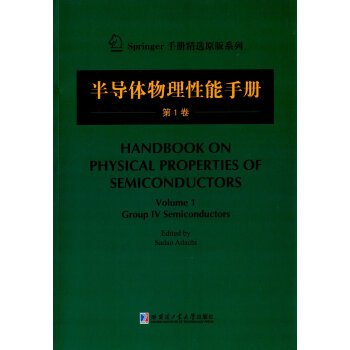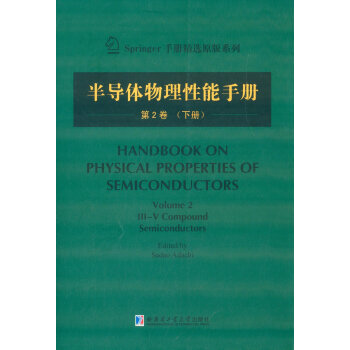

具体描述
目录
PrefaceAcknowledgments
Contents of Other Volumes
1 Diamond (C)
1.1 Structural Properties
1.1.1 Ionicity
1.1.2 Elemental Isotopic Abundance and Molecular Weight
1.1.3 Crystal Structure and Space Group
1.1.4 Lattice Constant and Its Related Parameters
1.1.5 Structural Phase Transition
1.1.6 Cleavage Plane
1.2 Thermal Properties
1.2.1 Melting Point and Its Related Parameters
1.2.2 Specific Heat
1.2.3 Debye Temperature
1.2.4 Thermal Expansion Coefficient
1.2.5 Thermal Conductivity and Diffusivity
1.3 Elastic Properties
1.3.1 Elastic Constant
1.3.2 Third—Order Elastic Constant
1.3.3 Young's Modulus, Poisson's Ratio, and Similar
1.3.4 Microhardness
1.3.5 Sound Velocity
1.4 Phonons and Lattice Vibronic Properties
1.4.1 Phonon Dispersion Relation
1.4.2 Phonon Frequency
1.4.3 Mode Gruneisen Parameter
1.4.4 Phonon Deformation Potential
1.5 Collective Effects and Related Properties
1.5.1 Piezoelectric Constant
1.5.2 Frohlich Coupling Constant
1.6 Energy—Band Structure: Energy—Band Gaps
1.6.1 Basic Properties
1.6.2 E0—Gap Region
1.6.3 Higher—Lying Direct Gap
1.6.4 Lowest Indirect Gap
1.6.5 Conduction—Valley Energy Separation
1.6.6 Direct—Indirect—Gap Transition Pressure
1.7 Energy—Band Structure: Electron and Hole Effective Masses
1.7.1 Electron Effective Mass: Γ Valley
1.7.2 Electron Effective Mass: Satellite Valley
1.7.3 Hole Effective Mass
1.8 Electronic Deformation Potential
1.8.1 Intravalley Deformation Potential: Γ Point
1.8.2 Intravalley Deformation Potential: High—Symmetry Points
1.8.3 Intervalley Deformation Potential
1.9 Electron Affinity and Schottky Barrier Height
1.9.1 Electron Affinity
1.9.2 Schottky Barrier Height
1.10 Optical Properties
1.10.1 Summary of Optical Dispersion Relations
1.10.2 The Reststrahlen Region
1.10.3 At or Near the Fundamental Absorption Edge
1.10.4 The Interband Transition Region
1.10.5 Free—Carrier Absorption and Related Phenomena
1.11 Elastooptic, Electrooptic, and Nonlinear Optical Properties
1.11.1 Elastooptic Effect
1.11.2 Linear Electrooptic Constant
1.11.3 Quadratic Electrooptic Constant
1.11.4 Franz—Keldysh Effect
1.11.5 Nonlinear Optical Constant
1.12 Carrier Transport Properties
1.12.1 Low—Field Mobility: Electrons
1.12.2 Low—Field Mobility: Holes
1.12.3 High—Field Transport: Electrons
1.12.4 High—Field Transport: Holes
1.12.5 Minority—Carrier Transport: Electrons in ρ—Type Materials
1.12.6 Minority—Carrier Transport: Holes in n—Type Materials
1.12.7 Impact Ionization Coefficient
2 Silicon (Si)
2.1 Structural Properties
2.1.1 Ionicity
2.1.2 Elemental Isotopic Abundance and Molecular Weight
2.1.3 Crystal Structure and Space Group
2.1.4 Lattice Constant and Its Related Parameters
2.1.5 Structural Phase Transition
2.1.6 Cleavage Plane
2.2 Thermal Properties
2.2.1 Melting Point and Its Related Parameters
2.2.2 Specific Heat
2.2.3 Debye Temperature
2.2.4 Thermal Expansion Coefficient
2.2.5 Thermal Conductivity and Diffusivity
2.3 Elastic Properties
2.3.1 Elastic Constant
2.3.2 Third—Order Elastic Constant
2.3.3 Young's Modulus, Poisson's Ratio, and Similar
2.3.4 Microhardness
2.3.5 Sound Velocity
2.4 Phonons and Lattice Vibronic Properties
2.4.1 Phonon Dispersion Relation
2.4.2 Phonon Frequency
2.4.3 Mode Gruneisen Parameter
2.4.4 Phonon Deformation Potential
2.5 Collective Effects and Related Properties
2.5.1 Piezoelectric Constant
2.5.2 Frohlich Coupling Constant
2.6 Energy—Band Structure: Energy—Band Gaps
2.6.1 Basic Properties
2.6.2 E0—Gap Region
2.6.3 Higher—Lying Direct Gap
2.6.4 Lowest Indirect Gap
2.6.5 Conduction—Valley Energy Separation
2.6.6 Direct—Indirect—Gap Transition Pressure
2.7 Energy—Band Structure: Electron and Hole Effective Masses
2.7.1 Electron Effective Mass: Γ Valley
2.7.2 Electron Effective Mass: Satellite Valley
2.7.3 Hole Effective Mass
2.8 Electronic Deformation Potential
2.8.1 Intravalley Deformation Potential: Γ Point
2.8.2 Intravalley Deformation Potential: High—Symmetry Points
2.8.3 Intervalley Deformation Potential
2.9 Electron Affinity and Schottky Barrier Height
2.9.1 Electron Affinity
2.9.2 Schottky Barrier Height
2.10 Optical Properties
2.10.1 Summary of Optical Dispersion Relations
2.10.2 The Reststrahlen Region
2.10.3 At or Near the Fundamental Absorption Edge
2.10.4 The Interband Transition Region
2.10.5 Free—Carrier Absorption and Related Phenomena
2.11 Elastooptic, Electrooptic, and Nonlinear Optical Properties
2.11.1 Elastooptic Effect
2.11.2 Linear Electrooptic Constant
2.11.3 Quadratic Electrooptic Constant
2.11.4 Franz—Keldysh Effect
2.11.5 Nonlinear Optical Constant
2.12 Carrier Transport Properties
2.12.1 Low—Field Mobility: Electrons
2.12.2 Low—Field Mobility: Holes
2.12.3 High—Field Transport: Electrons
2.12.4 High—Field Transport: Holes
2.12.5 Minority—Carrier Transport: Electrons in p—Type Materials
2.12.6 Minority—Carrier Transport: Holes in n—Type Materials
2.12.7 Impact Ionization Coefficient
3 Germanium (C)
3.1 Structural Properties
3.1.1 Ionicity
3.1.2 Elemental Isotopic Abundance and Molecular Weight
3.1.3 Crystal Structure and Space Group
3.1.4 Lattice Constant and Its Related Parameters
3.1.5 Structural Phase Transition
3.1.6 Cleavage Plane
3.2 Thermal Properties
3.2.1 Melting Point and Its Related Parameters
3.2.2 Specific Heat
3.2.3 Debye Temperature
3.2.4 Thermal Expansion Coefficient
3.2.5 Thermal Conductivity and Diffusivity
3.3 Elastic Properties
3.3,1 Elastic Constant
3.3.2 Third—Order Elastic Constant
3.3.3 Young's Modulus, Poisson's Ratio, and Similar
3.3.4 Microhardness
3.3.5 Sound Velocity
3.4 Phonons and Lattice Vibronic Properties
3.4.1 Phonon Dispersion Relation
3.4.2 Phonon Frequency
3.4.3 Mode Gruneisen Parameter
3.4.4 Phonon Deformation Potential
3.5 Collective Effects and Related Properties
3.5.1 Piezoelectric Constant
3.5.2 Frohlich Coupling Constant
3.6 Energy—Band Structure: Energy—Band Gaps
3.6.1 Basic Properties
3.6.2 Eo—Gap Region
3.6.3 Higher—Lying Direct Gap
3.6.4 Lowest Indirect Gap
3.6.5 Conduction—Valley Energy Separation
3.6.6 Direct—Indirect—Gap Transition Pressure
3.7 Energy—Band Structure: Electron and Hole Effective Masses
3.7.1 Electron Effective Mass: F Valiey
3.7.2 Electron Effective Mass: Satellite Valley
3.7.3 Hole Effective Mass
3.8 Electronic Deformation Potential
3.8.1 Intravalley Deformation Potential: Γ Point
3.8.2 Intravalley Deformation Potential: High—Symmetry Points
3.8.3 Intervalley Deformation Potential
3.9 Electron Affinity and Schottky Barrier Height
3.9.1 Electron Affinity
3.9.2 Schottky Barrier Height
3.10 Optical Properties
3.10.1 Summary of Optical Dispersion Relations
3.10.2 The Reststrahlen Region
3.10.3 At or Near the Fundamental Absorption Edge
3.10.4 The Interband Transition Region
3.10.5 Free—Carrier Absorption and Related Phenomena
3.11 Elastooptic, Electrooptic, and Nonlinear Optical Properties
3.11.1 Elastooptic Effect
3.11.2 Linear Electrooptic Constant
3.11.3 Quadratic Electrooptic Constant
3.11.4 Franz—Keldysh Effect
3.11.5 Nonlinear Optical Constant
3.12 Carrier Transport Properties
3.12.1 Low—Field Mobility: Electrons
3.12.2 Low—Field Mobility: Holes
3.12.3 High—Field Transport: Electrons
3.12.4 High—Field Transport: Holes
3.12.5 Minority—Carrier Transport: Electrons in p—Type Materials
3.12.6 Minority—Carrier Transport: Holes in n—Type Materials
3.12.7 Impact Ionization Coefficient
4 Gray Tin (a—Sn)
4.1 Structural Properties
4.1.1 lonicity
4.1.2 Elemental Isotopic Abundance and Molecular Weight
4.1.3 Crystal Structure and Space Group
4.1.4 Lattice Constant and Its Related Parameters
4.1.5 Structural Phase Transition
4.1.6 Cleavage Plane
4.2 Thermal Properties
4.2.1 Melting Point and Its Related Parameters
4.2.2 Specific Heat
4.2.3 Debye Temperature
4.2.4 Thermal Expansion Coefficient
4.2.5 Thermal Conductivity and Diffusivity
4.3 Elastic Properties
4.3.1 Elastic Constant
4.3.2 Third—Order Elastic Constant
4.3.3 Young's Modulus, Poisson's Ratio, and Similar
4.3.4 Microhardness
4.3.5 Sound Velocity
4.4 Phonons and Lattice Vibronic Properties
4.4.1 Phonon Dispersion Relation
4.4.2 Phonon Frequency
4.4.3 Mode Gruneisen Parameter
4.4.4 Phonon Deformation Potential
4.5 Collective Effects and Related Properties
4.5.1 Piezoelectric Constant
4.5.2 Frohlich Coupling Constant
4.6 Energy—Band Structure: Energy—Band Gaps
4.6.1 Basic Properties
4.6.2 Eo—Gap Region
4.6.3 Higher—Lying Direct Gap
4.6.4 Lowest Indirect Gap
4.6.5 Conduction—Valley Energy Separation
4.6.6 Direct—Indirect—Gap Transition Pressure
4.7 Energy—Band Structure: Electron and Hole Effective Masses
4.7.1 Electron Effective Mass: Γ Valley
4.7.2 Electron Effective Mass: Satellite Valley
4.7.3 Hole Effective Mass
4.8 Electronic Deformation Potential
4.8.1 Intravalley Deformation Potential: Γ Point
4.8.2 Intravalley Deformation Potential: High—Symmetry Points
4.8.3 Intervalley Deformation Potential
4.9 Electron Affinity and Schottky Barrier Height
4.9.1 Electron Affinity
4.9.2 Schottky Barrier Height
4.10 Optical Properties
4.10.1 Summary of Optical Dispersion Relations
4.10.2 The Reststrahlen Region
4.10.3 At or Near the Fundamental Absorption Edge
4.10.4 The Interband Transition Region
4.10.5 Free—Carrier Absorption and Related Phenomena
4.11 Elastooptic, Electrooptic, and Nonlinear Optical Properties
4.11.1 Elastooptic Effect
4.11.2 Linear Electrooptic Constant
4.11.3 Quadratic Electrooptic Constant
4.11.4 Franz—Keldysh Effect
4.11.5 Nonlinear Optical Constant
4.12 Carrier Transport Properties
4.12.1 Low—Field Mobility: Electrons
4.12.2 Low—Field Mobility: Holes
4.12.3 High—Field Transport: Electrons
4.12.4 High—Field Transport: Holes
4.12.5 Minority—Carrier Transport: Electrons in p—Type Materials
4.12.6 Minority—Carrier Transport: Holes in n—Type Materials
4.12.7 Impact Ionization Coefficient
……
5 Cubic Silicon Carbide (3C—SiC)
6 Hexagonal Silicon Carbide (2H—, 4H—, 6H—SiC, etc.)
7 Rhombohedral Silicon Carbide (15R—, 21R—, 24R—SiC, etc.)
前言/序言
用户评价
我必须说,这本《半导体物理性能手册:第1卷》简直就是为我量身定做的。我一直对半导体技术充满好奇,但市面上大多数的书籍要么过于基础,要么就深入到让人望而生畏。这本手册恰好找到了那个完美的平衡点。它没有像一些教科书那样,一开始就抛出一堆复杂的数学公式,而是从最基本的概念讲起,逐步引导读者理解半导体材料的本质。我特别欣赏书中对“掺杂”这一概念的解释,它不是简单地说“掺杂会改变性能”,而是详细地分析了不同掺杂物如何影响载流子浓度,以及这些变化对材料导电性和光学性质的具体影响。读起来感觉就像跟着一位经验丰富的导师在实验室里一步步操作,亲眼见证着材料的“蜕变”。而且,手册中还穿插了一些历史背景和发展故事,这让原本可能枯燥的技术内容变得生动有趣。我了解到很多关键的发现是如何诞生的,以及科学家们是如何克服重重困难才取得突破的。这种人文关怀和科学精神的结合,让我在学习技术知识的同时,也感受到了科技进步的魅力。我已经迫不及待地想继续深入研究下去,看看它还有哪些精彩的内容。
评分哇,我最近入手的这本《半导体物理性能手册:第1卷》真是太给力了!老实说,一开始我只是抱着试试看的心态,想着大概就是一本枯燥的参考书,但翻开之后,完全颠覆了我的想象。它不仅仅是一本“手册”,更像是一本精心编织的学术小说,只不过主角是那些微小的、却拥有巨大能量的半导体材料。书中的内容,虽然我还没有完全消化,但那种严谨又不失趣味的叙述方式,一下子就把我拉进了半导体的奇妙世界。举个例子,书中关于能带理论的阐述,我之前在学校里学的时候总觉得晦涩难懂,但在这里,作者用了非常形象的比喻和图示,让我瞬间豁然开朗。仿佛一层层神秘的面纱被揭开,我看到了电子在晶体结构中是如何“跳舞”,又是如何影响材料的导电性的。而且,它并非只是罗列公式和数据,而是深入浅出地解释了这些“性能”是如何产生的,背后的物理机制是什么,这一点对我这个希望知其然也知其所以然的读者来说,简直是太重要了。我尤其喜欢书中对不同半导体材料特性对比的章节,那种条理清晰,逻辑严谨的分析,让我能够快速抓住不同材料的优缺点,以及它们在特定应用场景下的优势。虽然我还没有遇到书中提到的所有具体应用,但通过这本书,我已经对未来科技发展有了更深的理解和期待。
评分说实话,我拿到《半导体物理性能手册:第1卷》的时候,并没有抱太高的期望,想着可能就是一本冰冷的、只提供数据的工具书。然而,它的实际内容完全出乎我的意料,带来了一种全新的阅读体验。这本书的内容编排非常有特色,它不仅仅是简单地罗列各种半导体材料的物理参数,而是将这些参数与实际的应用场景紧密地联系起来。比如,在介绍某种材料的击穿电压时,它会顺带解释这种材料在高温高压环境下工作时的表现,以及可能遇到的挑战。这种“情景式”的学习方法,让我觉得非常实用,也更容易理解这些参数的意义。我特别喜欢其中关于“界面物理”的章节,在电子设备中,不同材料之间的接口往往是性能瓶颈所在,而这本书对这些界面效应进行了深入细致的分析,提供了很多有价值的见解。我之前在工作中就遇到过一些与界面相关的技术难题,现在有了这本书,感觉茅塞顿开,找到了解决问题的思路。它让我意识到,半导体物理远不止是课堂上的理论,更是实际工程中需要面对的真实挑战。
评分这本书的出现,真像是在我学习半导体物理的道路上投下了一束光。我之前在阅读一些文献时,经常会遇到一些看似通用但实际操作起来却模棱两可的参数定义,让人无所适从。而《半导体物理性能手册:第1卷》在这方面做得非常出色,它对每一个性能参数都进行了清晰、准确的定义,并且提供了详细的测量方法和影响因素分析。我最欣赏它对“迁移率”的讲解,不仅仅是给出一个数值,而是深入剖析了温度、掺杂浓度、晶格缺陷等多种因素如何影响迁移率,以及它在不同类型的半导体中表现出的差异。这种严谨的态度,让我对书中提供的所有数据都充满了信任。而且,手册中的图表和插图也设计得非常精良,直观易懂,大大降低了理解难度。它就像一个经验丰富的向导,带领我一步步深入探索半导体世界的奥秘,让我能够更清晰地认识到不同材料的“个性”和“能力”,并为我未来的研究方向指明了道路。
评分对于我这样一名有一定基础但又想进一步提升理论深度的读者来说,《半导体物理性能手册:第1卷》简直是一个宝藏。它不像某些入门书籍那样浅尝辄止,也没有像某些高级专著那样晦涩难懂。这本书的深度恰到好处,能够满足我不断学习的需求。我非常喜欢书中对“激子”和“自由载流子”的讲解,它不仅提供了详细的数学模型,还结合了实验现象进行解释,让我能够更直观地理解这些微观粒子在半导体中的行为。而且,书中还包含了一些前沿的研究方向和未来趋势的讨论,这让我对这个领域的发展保持了敏锐的洞察力。我尤其对书中关于“量子尺寸效应”的部分印象深刻,它揭示了当材料尺寸缩小到纳米级别时,其物理性能会发生怎样的巨大变化。这让我联想到很多新兴的科技应用,比如纳米电子学和量子计算,感觉这本书就像一座桥梁,连接着现在的理论和未来的无限可能。
相关图书
本站所有内容均为互联网搜索引擎提供的公开搜索信息,本站不存储任何数据与内容,任何内容与数据均与本站无关,如有需要请联系相关搜索引擎包括但不限于百度,google,bing,sogou 等
© 2025 book.teaonline.club All Rights Reserved. 图书大百科 版权所有



















![国防科技著作精品译丛:无线电干涉测量与卫星跟踪 [Radio Interferometry and Satellite Tracking] pdf epub mobi 电子书 下载](https://pic.qciss.net/11585813/547e6148N16f320f0.jpg)
